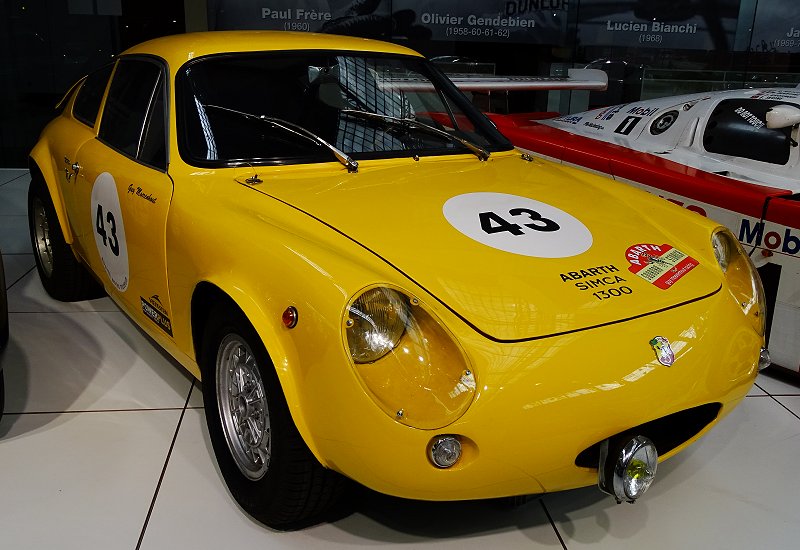Behind every legendary race car lies a story of innovation and daring. The 1962 Abarth Simca 1300 Bialbero S1 stands as one of the most fascinating examples of Franco-Italian collaboration in motorsport history. Weighing just 630 kg and powered by a sophisticated dual-overhead-cam engine, this race-bred machine redefined what was possible in its class.
This pocket rocket emerged during the golden age of motorsport, when racing truly drove innovation. The partnership between Abarth’s engineering prowess and Simca’s manufacturing capabilities produced something extraordinary — a purpose-built racing car that could hit 200 km/h while maintaining impeccable handling characteristics.
Engineering Excellence
The heart of this racing thoroughbred beats with Italian passion. The 1288cc four-cylinder engine features an advanced dual-overhead-cam system, explaining the “Bialbero” designation. With 90 horsepower at 6000 rpm flowing through a six-speed manual transmission, the power-to-weight ratio proved exceptional for its era.
Engineers achieved these impressive numbers through meticulous attention to detail. The engine’s 76mm bore and 71mm stroke, combined with a 9.6:1 compression ratio, delivered optimal performance while maintaining reliability. Twin Weber carburetors fed fuel to the eager powerplant, enabling precise mixture control crucial for racing conditions.
“The Bialbero’s engine represented the pinnacle of 1960s naturally aspirated technology. Its combination of power delivery and reliability was remarkable for its time.” — Marco Rossi, Classic Racing Engineer
The lightweight construction and balanced chassis dynamics created a responsive and agile racing platform. Advanced for its time, the cooling system and wet-sump lubrication ensured consistent performance under racing conditions.
Racing DNA
Every curve and contour of the Bialbero S1’s compact 3555mm length serves a purpose. The streamlined body, standing just 1140mm tall, cuts through air efficiently while maintaining stability at speed. These dimensions, combined with its modest 1480mm width, created an ideal package for both circuit racing and hill climbs.
Fact!
The Bialbero designation comes from the Italian word for 'dual camshaft,' reflecting the advanced engine technology that set this car apart from its contemporaries.
Track success demanded more than just straight-line speed. The sophisticated suspension system, coupled with disc brakes, provided the handling precision required for competitive racing. The rear-engine layout, while challenging to master, offered superior traction out of corners.
“Racing the Bialbero required skill, but once mastered, it was like dancing with a perfectly balanced partner.” — Henri Laurent, Vintage Racing Champion
The fixed-head coupe design prioritized aerodynamic efficiency over comfort, reflecting its pure racing purpose. Every gram saved contributed to enhanced performance, making it a formidable competitor on European circuits.
Legacy and Influence
Few cars of this era combined such advanced engineering with pure racing focus. The Bialbero S1 showcased Abarth’s ability to transform production car platforms into competitive racing machines, establishing a template that influenced sports car development for years to come.
Historical Reference!
The collaboration between Abarth and Simca marked one of the first successful Franco-Italian partnerships in motorsport, paving the way for future international racing collaborations.
Today, surviving examples command respect among collectors and historians alike. The limited production run ensures their place as coveted pieces of racing history, each one telling a story of an era when engineering innovation knew no bounds.
The car’s influence extends beyond its racing achievements. Its development process demonstrated how international collaboration could produce extraordinary results, setting a precedent for future partnerships in the automotive industry.
Built for Speed, Destined for Legend
The Abarth Simca 1300 Bialbero S1 represents more than just a successful racing car. It embodies the spirit of 1960s motorsport, when passionate engineers pushed boundaries without the aid of modern technology.
Its legacy lives on through its influence on racing car design and the memories of those who witnessed its capabilities on track. Few cars of its era combined such advanced engineering with raw racing purpose.
Pros & Cons
| Advantages | Disadvantages |
|---|---|
| Exceptional power-to-weight ratio with 90 hp moving just 630 kg | Limited production numbers make finding parts challenging |
| Advanced DOHC engine technology for its time | High fuel consumption due to racing focus |
| Superior handling thanks to sophisticated suspension | Requires significant expertise to maintain |
| Impressive top speed of 200 km/h | Limited practicality as a pure racing machine |
| Historical significance as an Abarth-Simca collaboration | Demanding driving characteristics |
| Innovative aerodynamic design | High collectible status affects accessibility |
| Racing-proven reliability | Specialized mechanical knowledge required |
The Abarth Simca 1300 Bialbero S1 stands as a testament to what’s possible when engineering excellence meets racing ambition. While it demands respect and expertise to own and maintain, its place in automotive history remains secure as one of the most significant racing cars of its era.

